英语时态:现在完成时和现在完成进行时区别、过去完成时与现在完成时区别
现在完成时、过去完成时、现在完成进行时
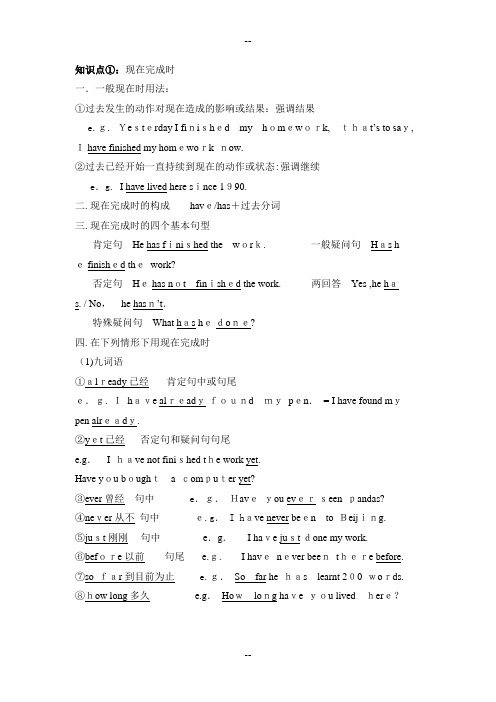
(4)如果句子里面没有时间状语,汉语意思能够加“已经”,往往用现在完成时态。
e.g.Have you lost your library book?你已经弄丢了从图书馆借的那本书吗?(5)现在完成时态还常常用于下列句型They have planted manytrees in thelast few years. 在过去的几年,他们已经种了很多树。
Thisisthe best book I have ever read. 这是我曾经读过的最好的一本书。
It is the firsttimeI have played the computer games.这是我第一次玩电脑游戏。
五.在现在完成时中,一次性动词不能和一段时间状语连用e.g. He has bought the book for3years.(错)因buy这个一次性动词不能和一段时间for 3years连用,改正的办法有五种:①He hasbought the book.. (去掉一段时间for3 years)②He boughtthebook 3 yearsago (改为一般过去时,使句子的意思不变)③It’s 3years sincehe boughtthe book.=3yearshas passed sincehe bought the book.(改为固定句型 It is ---since---)④Hehas not boughtthebook for 3 years.(改为否定句)⑤ He hashad thebook for 3years. (用延续性动词have代替buy)六.还有其他一次性动词也是这种情况,可参照前面的五种办法改正,前四种改法都一样,第五种改法各不相同,举例如下:①come/arrive/get to/reach → behere例:I havecome here for3years.(错)改为:I have been here for 3 years.②leave/go →be away例:He has left for 3hours.(错)改为:He hasbeenaway for 3 hours.③begin/start →be on例:The film hasbegun for 3 minutes.(错)改为:The film ha sbeenon for 3 minutes.④open→be open/close→ be closed例:The shop has opened for3 years.(错) 改为:The shop has b een open for 3years.⑤die→be dead例:His father hasdied for 3 years.(错) 改为:Hisfather has been dead for3years.⑥finish/end→ be over例:He has finished the work for 3 days.(错)改为:The work ha sbeenover for 3 days⑦join例:I havejoined the armyfor 3 years.(错)改为:I havebeen inthearmy for 3 years. 或I have been a soldierfor3years.⑧buy /catch → havee.g. I have boughtthe bike for 3years.(错)改为:I have had the bike for 3 years.e.g.Hehas caught a cold for 3 days.(错)改为:He has had a cold for3days.⑨borrow → keepe.g.I have borrowed the book for 3 years. (错)改为:I have kept the book for3years.还有其它的归纳如下:break→be broken get up → be upmarry→ bemarried become → be lose → be lost七.延续性动词和终止性动词①延续性动词:表示的动作是能延续的动作,这种动作可以延续下去或产生持久的影响。
完成时的四种时态的基本结构

完成时的四种时态的基本结构完成时态是英语中最常用的时态之一,它表示过去某个时间点或时间段已经完成的动作或状态。
完成时态有四种基本结构,分别是现在完成时、过去完成时、将来完成时和完成进行时。
下面将分别介绍这四种时态的基本结构和用法。
一、现在完成时现在完成时的基本结构是“have/has + 过去分词”,其中have用于第一人称单数、第二人称单数和复数,has用于第三人称单数。
现在完成时表示过去发生的动作或状态对现在造成的影响或结果,常用于以下情况:1. 表示过去发生的动作或状态对现在造成的影响或结果,如:I have lost my keys.(我丢了我的钥匙。
)She has been studying English for five years.(她已经学习英语五年了。
)2. 表示过去发生的动作或状态一直持续到现在,如:I have lived in this city for ten years.(我在这个城市住了十年了。
) He has worked for this company since 2010.(他自2010年以来一直在这家公司工作。
)3. 表示过去发生的动作或状态与现在有关联,如:I have just finished my homework.(我刚刚完成了我的作业。
)She has already left for the airport.(她已经去机场了。
)二、过去完成时过去完成时的基本结构是“had + 过去分词”,表示在过去某个时间点或时间段之前已经完成的动作或状态。
过去完成时常用于以下情况:1. 表示过去某个时间点或时间段之前已经完成的动作或状态,如:I had finished my work before he arrived.(他到达之前我已经完成了我的工作。
)She had lived in Paris for two years before she moved to London.(她在搬到伦敦之前在巴黎住了两年。
高中英语时态总结
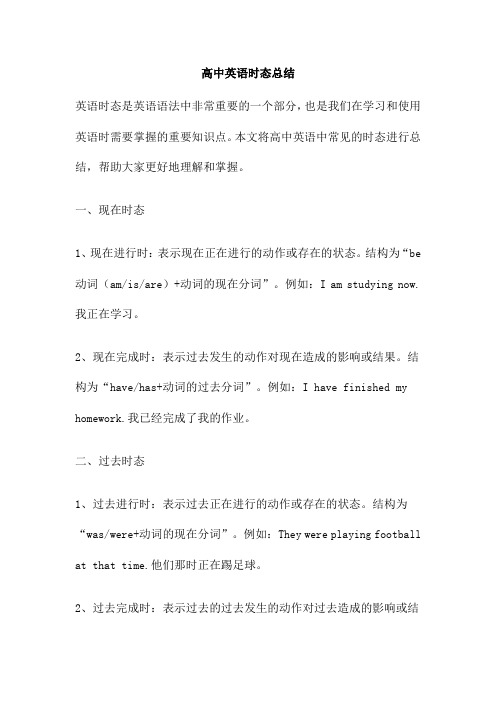
高中英语时态总结英语时态是英语语法中非常重要的一个部分,也是我们在学习和使用英语时需要掌握的重要知识点。
本文将高中英语中常见的时态进行总结,帮助大家更好地理解和掌握。
一、现在时态1、现在进行时:表示现在正在进行的动作或存在的状态。
结构为“be 动词(am/is/are)+动词的现在分词”。
例如:I am studying now.我正在学习。
2、现在完成时:表示过去发生的动作对现在造成的影响或结果。
结构为“have/has+动词的过去分词”。
例如:I have finished my homework.我已经完成了我的作业。
二、过去时态1、过去进行时:表示过去正在进行的动作或存在的状态。
结构为“was/were+动词的现在分词”。
例如:They were playing football at that time.他们那时正在踢足球。
2、过去完成时:表示过去的过去发生的动作对过去造成的影响或结果。
结构为“had+动词的过去分词”。
例如:They had finished their work before we arrived.他们在我们到达之前已经完成了他们的工作。
三、将来时态1、将来进行时:表示将来某个时间正在进行的动作或存在的状态。
结构为“will+be动词+动词的现在分词”。
例如:I will be studying at 9 o’clock tomorrow.我明天9点将会在学习。
2、将来完成时:表示将来某个时间已经完成的动作或达到的状态。
结构为“will+have+动词的过去分词”。
例如:I will have finished my homework by 10 o’clock tonight.我将在今晚10点之前完成我的作业。
以上是高中英语中常见的时态总结,希望能够帮助大家更好地理解和掌握英语时态。
需要注意的是,不同的时态有着不同的用法和结构,大家在使用时需要根据语境选择合适的时态。
英语时态:现在完成时和现在完成进行时区别、过去完成时及现在完成时区别
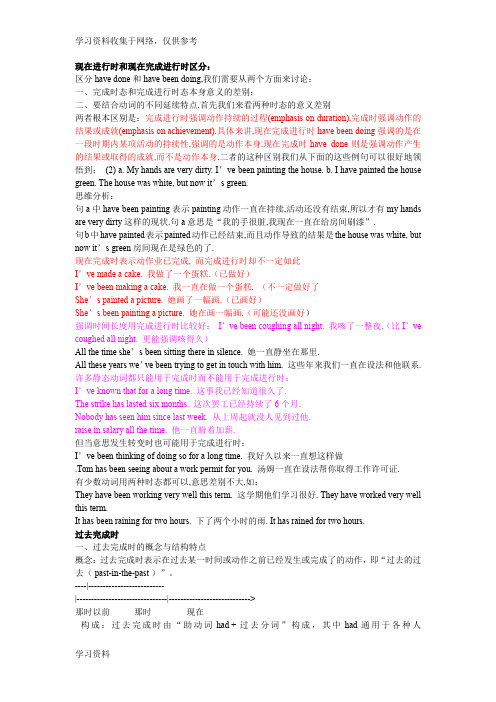
现在进行时和现在完成进行时区分:区分have done和have been doing,我们需要从两个方面来讨论:一、完成时态和完成进行时态本身意义的差别;二、要结合动词的不同延续特点.首先我们来看两种时态的意义差别两者根本区别是:完成进行时强调动作持续的过程(emphasis on duration),完成时强调动作的结果或成就(emphasis on achievement).具体来讲,现在完成进行时have been doing强调的是在一段时期内某项活动的持续性,强调的是动作本身.现在完成时have done则是强调动作产生的结果或取得的成就,而不是动作本身.二者的这种区别我们从下面的这些例句可以很好地领悟到:(2) a. My hands are very dirty. I’ve been painting the house. b. I have painted the house green. The house was white, but now it’s green.思维分析:句a中have been painting表示painting动作一直在持续,活动还没有结束,所以才有my hands are very dirty这样的现状.句a意思是“我的手很脏,我现在一直在给房间刷漆”.句b中have painted表示painted动作已经结束,而且动作导致的结果是the house was white, but now it’s green房间现在是绿色的了.现在完成时表示动作业已完成, 而完成进行时却不一定如此I’ve made a cake. 我做了一个蛋糕.(已做好)I’ve been making a cake. 我一直在做一个蛋糕. (不一定做好了She’s painted a picture. 她画了一幅画.(已画好)She’s been painting a picture. 她在画一幅画.(可能还没画好)强调时间长度用完成进行时比较好:I’ve been coughing all night. 我咳了一整夜.(比I’ve coughed all night. 更能强调咳得久)All the time she’s been sitting there in silence. 她一直静坐在那里.All these years we’ve been trying to get in touch with him. 这些年来我们一直在设法和他联系. 许多静态动词都只能用于完成时而不能用于完成进行时:I’ve known that for a long time. 这事我已经知道很久了.The strike has lasted six months. 这次罢工已经持续了6个月.Nobody has seen him since last week. 从上周起就没人见到过他.raise in salary all the time. 他一直盼着加薪.但当意思发生转变时也可能用于完成进行时:I’ve been thinking of doing so for a long time. 我好久以来一直想这样做.Tom has been seeing about a work permit for you. 汤姆一直在设法帮你取得工作许可证.有少数动词用两种时态都可以,意思差别不大,如:They have been working very well this term. 这学期他们学习很好. They have worked very well this term.It has been raining for two hours. 下了两个小时的雨. It has rained for two hours.过去完成时一、过去完成时的概念与结构特点概念:过去完成时表示在过去某一时间或动作之前已经发生或完成了的动作,即“过去的过去( past-in-the-past )”。
初中英语语法:各个时态的标志和时态间的区别

英语中各个时态的标志和时态间的区别一)一般现在时。
(do/does, am/is/are, 情态动词)a. 一般现在时表示的是客观事实或平时反复做的事情通常有频率副词always,usually,often,sometimes,seldom,once a week,every day等。
如:The earth goes around the sun.Japan lies east of China.He is never late for school.He often gets up at six every day.Cats can climb trees.I hear they have moved into a new house.He writes to his father once a year.b.一般现在时还可以表示、安排好的,或即将发生的事,通常使用瞬间动词come,start,begin,return,leave等。
如:My plane leaves at 6:00 a.m..Is there any meeting today?The game starts at 8:00.(二)现在进行时。
(am/is/are doing)a.现在进行时表示现在或最近正在做的事情,后面一般接延续性的动词,都表示动作没有进行完。
如:Look! The boy is dancing.He is watching a football game.What are you doing now?They are preparing for the exam recently.b.还常与always,usually,constantly,forever,continually等词连用表示一种语气,“总是,老是…”,如:He is always working late.Why are you always making this kind of mistake?He is continually getting into trouble with the police.c.后面接暂转动词时表示正在反复的动作,或表示将来时(一般只有go, come, leave 和have)如:The monkeys are jumping.They are hitting the tree.表将来:We are going swimming this afternoon.They are leaving here.They are having an English class tomorrow.试比较:He is doing his homework until his parents come to take him home.He will do his homework until his parents come to take him home.注:表示知觉、感觉、看法、认识、情感或愿望的动词和大部分暂转动词不能用现在进行时。
英语时态的区别

现在时
现在完成进行时
现在完成进行时表示过去开始 的动作一直持续到现在,并且 可能会继续下去。它的基本形 式是have/has加上动词的现在 分词形式。例如:I have been studying for the past hour 。我学习了一个小时了
2
过去时
过去时表示过去发生的事情。它包括一般过 去时、过去进行时、过去完成时和过去完成 进行时
将来时
将来进行时
将来进行时表示将来某个时间正在进行的动作或存在的状态。它的基本形式是will加 上动词的现在分词形式或用be going to表示。例如:I will be studying at this time tomorrow night.我明天晚上这个时候将会在学习。(或)I'm going to be studying at this time tomorrow night.我打算明天晚上这个时候将会在学习
完成进行时
现在时
现在进行时
现在进行时表示正在进行的动 作或存在的状态。它的基本形 式是be动词加上动词的现在分 词形式。例如:I am studying 。我正在学习
现在时
现在完成时
现在完成时表示过去发生的动作对现在造 成的影响或结果。它的基本形式是 have/has加上动词的过去分词形式。例如 :I have finished my homework。我已 经完成了我的作业
(或)He said he was going to be studying for the exam at this time tomorrow night.他说他打 算明天晚上这个时候将会在备考考试
6
过去将来完成时
过去将来完成时表示在过去某个时间对未来的某个动作已经完成的预测或过 去的某个条件下的结果
时态的基本用法和区别

时态的基本用法和区别时态是语言中非常重要的概念,它用来表示动作或状态发生的时间。
在英语中,时态分为简单时态、进行时态、完成时态以及完成进行时态。
每种时态都有其特定的用法和区别。
本文将对这些时态进行详细介绍。
一、简单时态:简单时态用于表达经常发生的动作、客观事实、习惯、常规和真理等。
下面分别介绍简单时态的三个形式及其用法和区别。
1.一般现在时:一般现在时用于表达经常性的行为、客观事实以及普遍真理。
它的基本结构是主语+动词原形。
例如:- I eat breakfast every morning.(我每天早上吃早餐。
)- Water boils at 100 degrees Celsius.(水在100摄氏度沸腾。
)2.一般过去时:一般过去时用于过去发生的动作或状态,它的基本结构是主语+动词的过去式。
例如:- She studied English last night.(她昨晚学习了英语。
)- We lived in London for three years.(我们在伦敦住了三年。
)3.一般将来时:一般将来时用于表示将来要发生的动作或状态,它的基本结构是主语+will/shall+动词原形。
例如:- They will visit their grandparents next month.(他们下个月会去看望他们的祖父母。
)- I shall finish my homework before dinner.(我要在晚餐前完成我的作业。
)二、进行时态:进行时态用于表达正在进行的动作,它强调动作的持续性和暂时性。
下面介绍进行时态的三个形式及其用法和区别。
1.现在进行时:现在进行时用于表示现在正在进行的动作,它的基本结构是主语+am/is/are+动词的ing形式。
例如:- He is reading a book now.(他现在正在读一本书。
)- They are playing soccer in the park.(他们在公园里踢足球。
英语中现在完成时和现在完成进行时怎么区分,过去完成时和过去完成进行时又该怎么区分?.doc

英语中现在完成时和现在完成进行时怎么区分,过去完成时和过去完成进行时又该怎
么区分?
这个问题解决不难。
你要记住以下几点即可。
1,凡是用进行时的,肯定是要突出动作正在发生中,否则就不要用进行时。
比如,I have lived here for 5 years和I have been living here for 5 years。
这两句都很常见,区别就在于,前一句只是说明到现在为止已经完成的状态,但不知道说话时,这个动作是否还在进行。
而后一个句子不仅说到目前完成的状态,还强调在说话时动作还在进行中。
2,现在完成时和过去完成时的区别。
在做时态题目时,要看两点,一是句子当中明确给出的时间,比如看到了in the past +时间,我们一般就用现在完成时。
例如,in the past ten years, English has been taught in a new way in this school。
其次要看句子中别的动词用哪种时态,然后对比两个动词的发生顺序。
比如,English had been taught for 6 minutes when I arrived。
此句,当我到达的时候,英语已经上了6分钟了。
teach和arrive的发生有个顺序。
高中英语时态用法:现在完成进行时和过去完成式

高中英语时态用法:现在完成进行时和过去完成式中学英语涉及到的时态一共有16种,下面给大家准备了现在完成进行时用法说明,希望对大家复习备考有帮助。
高中英语十六种时态用法详解之现在完成进行时1. 现在完成进行时的定义现在完成进行时表示某动作从过去某个时间开始,一直延续到现在,并且还有可能持续下去。
如:We have been waiting for him for two hours. 我们等他等了两个小时。
2. 现在完成进行时的结构现在完成进行时由“have /has been + 现在分词”构成。
3. 现在完成进行时的应用现在完成进行时所用的时间状语:this month / week / year, these days, recently / lately, in the past few + 时间段, since +时间点, for + 时间段。
如:They have been building the bridge for two month. 两个月来他们一直在修桥。
They have been planting trees this month. 这个月来他们一直在植树。
4. 现在完成进行时与现在完成时的区别(1) 现在完成时强调动作的完成,而现在完成进行时强调动作的延续,因此,表示动作的完成,只能用现在完成时,而不能用现在完成进行时。
如:He has changed his idea. 他改变了想法。
(2) 在表示动作的延续时,虽然既可用现在完成时,也可用现在完成进行时,但现在完成进行时强调动作的进行。
因此在需要明确表示动作还要持续下去时,应用现在完成进行时。
如:We have been studying here for two years. 我们在这儿已经学习了两年了。
(3) 有些延续性动词(如 keep, learn, live, stay, study, work等),用于现在完成时或现在完成进行时的区别不大。
英语时态:现在完成时和现在完成进行时区别、过去完成时及现在完成时区别
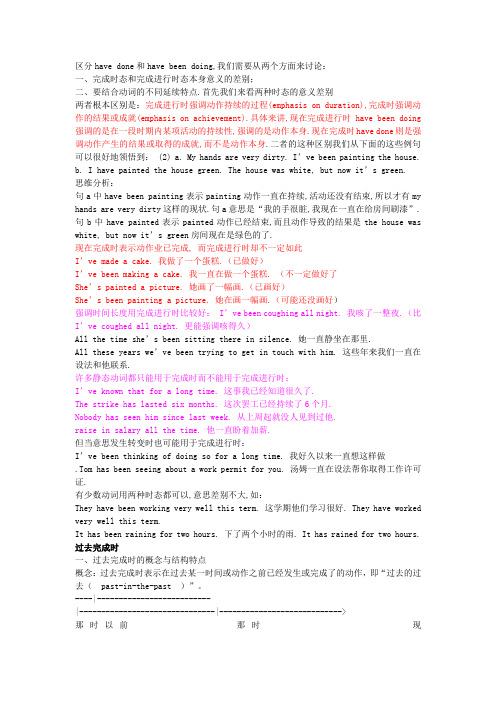
区分have done和have been doing,我们需要从两个方面来讨论:一、完成时态和完成进行时态本身意义的差别;二、要结合动词的不同延续特点.首先我们来看两种时态的意义差别两者根本区别是:完成进行时强调动作持续的过程(emphasis on duration),完成时强调动作的结果或成就(emphasis on achievement).具体来讲,现在完成进行时have been doing 强调的是在一段时期内某项活动的持续性,强调的是动作本身.现在完成时have done则是强调动作产生的结果或取得的成就,而不是动作本身.二者的这种区别我们从下面的这些例句可以很好地领悟到: (2) a. My hands are very dirty. I’ve been painting the house.b. I have painted the house green. The house was white, but now it’s green.思维分析:句a中have been painting表示painting动作一直在持续,活动还没有结束,所以才有my hands are very dirty这样的现状.句a意思是“我的手很脏,我现在一直在给房间刷漆”. 句b中have painted表示painted动作已经结束,而且动作导致的结果是the house was white, but now it’s green房间现在是绿色的了.现在完成时表示动作业已完成, 而完成进行时却不一定如此I’ve made a cake. 我做了一个蛋糕.(已做好)I’ve been making a cake. 我一直在做一个蛋糕. (不一定做好了She’s painted a picture. 她画了一幅画.(已画好)She’s been painting a picture. 她在画一幅画.(可能还没画好)强调时间长度用完成进行时比较好: I’ve been coughing all night. 我咳了一整夜.(比I’ve coughed all night. 更能强调咳得久)All the time she’s been sitting there in silence. 她一直静坐在那里.All these years we’ve been trying to get in touch with him. 这些年来我们一直在设法和他联系.许多静态动词都只能用于完成时而不能用于完成进行时:I’ve known that for a long time. 这事我已经知道很久了.The strike has lasted six months. 这次罢工已经持续了6个月.Nobody has seen him since last week. 从上周起就没人见到过他.raise in salary all the time. 他一直盼着加薪.但当意思发生转变时也可能用于完成进行时:I’ve been thinking of doing so for a long time. 我好久以来一直想这样做.Tom has been seeing about a work permit for you. 汤姆一直在设法帮你取得工作许可证.有少数动词用两种时态都可以,意思差别不大,如:They have been working very well this term. 这学期他们学习很好. They have worked very well this term.It has been raining for two hours. 下了两个小时的雨. It has rained for two hours.过去完成时一、过去完成时的概念与结构特点概念:过去完成时表示在过去某一时间或动作之前已经发生或完成了的动作,即“过去的过去(past-in-the-past )”。
时态和语态的区别和用法

时态和语态的区别和用法时态和语态是英语中非常重要的语法概念,对于学习英语的人来说特别重要。
时态和语态的正确使用能够准确表达出动作发生的时间和动作主体的关系,使语言更加准确、流畅。
本文将详细介绍时态和语态的区别和用法。
一、时态的定义和用法时态表示动作或状态发生的时间。
英语中常用的时态主要包括: 简单现在时、现在进行时、现在完成时、过去时、过去进行时、过去完成时、将来时等。
1. 简单现在时:表示经常、一贯性或普遍性的动作或状态。
例如:I eat breakfast every day.(我每天吃早餐)2. 现在进行时:表示现在时刻正在进行的动作。
例如:They are playing football in the park.(他们正在公园里踢足球)3. 现在完成时:表示过去某个时间点开始、持续到现在的动作。
例如:He has lived in London for five years.(他在伦敦住了五年了)4. 过去时:表示过去某个时间点或某段时间内发生的动作。
例如:She went to the cinema last night.(昨晚她去了电影院)5. 过去进行时:表示过去某个时间点或某段时间内正在进行的动作。
例如:He was studying when I called him.(我给他打电话时,他正在学习)6. 过去完成时:表示过去某个时间点之前已经完成的动作。
例如:They had finished their homework before dinner.(晚餐前,他们已经做完了作业)7. 将来时:表示将来某个时间点或某段时间内将要发生的动作。
例如:I will go shopping tomorrow.(明天我要去购物)二、语态的定义和用法语态表示句中主语和谓语动词的关系,主要包括:主动语态和被动语态。
1. 主动语态:表示主语是动作的执行者。
例如:He wrote a letter.(他写了一封信)2. 被动语态:表示主语是动作的承受者。
现在完成时、现在完成进行时、过去完成时、过去将来时
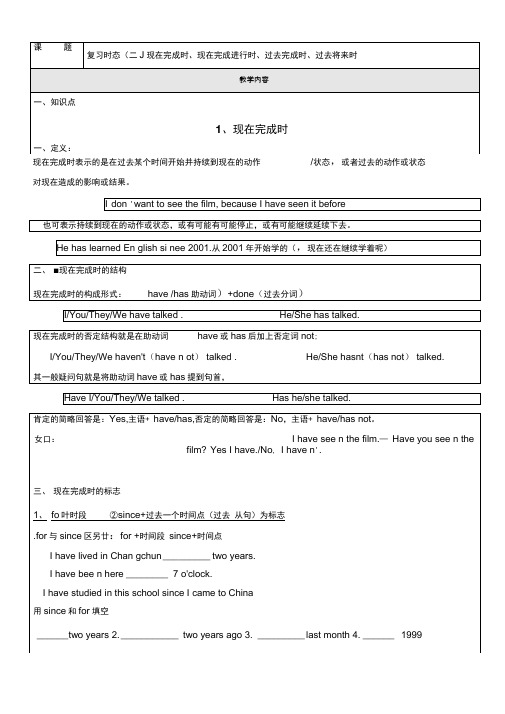
现在完成时表示的是在过去某个时间开始并持续到现在的动作/状态,或者过去的动作或状态对现在造成的影响或结果。
leave --- be away borrow --- keep buy --- h avedie --- be dead finish --- be over fall ill--■-be illget up---be up catch a cold --- have a coldgo there --- be there become --- befall asleep --- be asleep get to/ arrive/reach --- b e (in)get to know --- know go (get) out—be out put or—wearjoin----be a member of ... (成为…的一贝)ope n ---be openbegi n/start --- be oncome here --- be here come back --- be back leave --- be away fromclose ---be closedI have already fini shed my homework. already用在 _______ ,位于 _________ 。
“已经”Have you finished your homework yet? yet用在__________ 和_________ 中,位于__________ 。
“仍然,已经”3)so far(目前;迄今为止)up to now=till now=by now 至U现在为止;直至U现在recently最近by the end of …至U …末/ 结束by the end of this year 至U 今年年末by the end of this mon th 到本月末in the last /past mon ths在过去的几个月中in the past/last few days/years在过去的这几天4、用于现在完成时的句型1) It is the first / seco nd time that+ 现在完成时。
16种英语时态的讲解
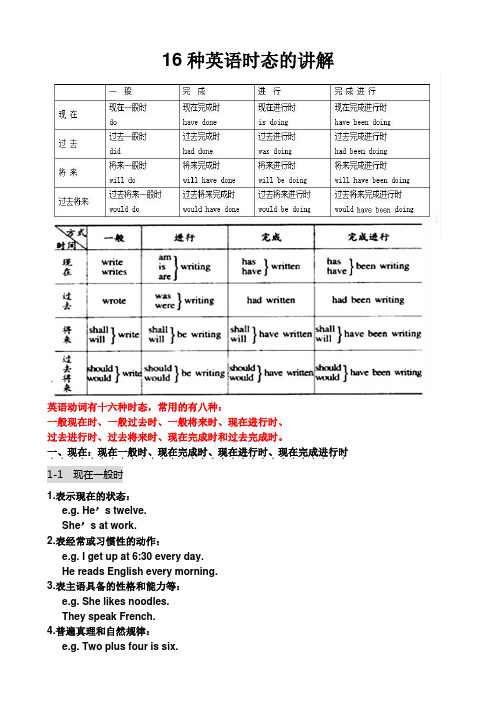
16种英语时态的讲解英语动词有十六种时态,常用的有八种:一般现在时、一般过去时、一般将来时、现在进行时、过去进行时、过去将来时、现在完成时和过去完成时。
一、现在:现在一般时、现在完成时、现在进行时、现在完成进行时..............................1-1 现在一般时1.表示现在的状态:e.g. He’s twelve.She’s at work.2.表经常或习惯性的动作:e.g. I get up at 6:30 every day.He reads English every morning.3.表主语具备的性格和能力等:e.g. She likes noodles.They speak French.4.普遍真理和自然规律:e.g. Two plus four is six.The moon goes around the earth.一般动词:主语是第一人称单复数时,没有变化;主语是第三人称时,动词+s,以sh /ch/ s/x /z/ o 加es,以y结尾的,前面是元音字母的直接加es,前面是辅音字母的,把y改i加es。
1-2 现在完成时现在完成时构成: have/has + 动词的过去分词1.定义:现在完成时表示到目前为止已经完成,并对现在留下某种后果和影响的动作。
1.表示过去发生的某一动作对现在造成的影响或结果,常与一些时间状语2.表示过去发生的动作或存在的状态,一直持续到现在,也许还将继续下去,可以和表示从过去某一时刻延续到现在的一段时间的状语连用如:already已经,早以, yet仍然,还, ever曾经, never从不;决不,从未,从来没有, just 刚刚,仅仅, before在···之前, once一次,曾经,twice两次,两倍,等连用,也可以和包括现在在内的时间状语,如these days,today,this year,so far(目前,到目前为止)等连用.即for +时间段,since(自从)+时间点/从句, in the last ten years等,谓语只可用延续性动词.2. has/have been to 去过某地表示某人的一种经历,可与once,twice,already,ever,never,等连用。
现在完成时的结构_过去完成时和现在完成时的区别

现在完成时的结构_过去完成时和现在完成时的区别相信大家对现在完成时都很了解, 不过说到过去完成进行时或许大家就会有疑惑.现在给大家整理这两个时态的区别,让大家对过去完成时和现在完成时有更多的了解.现在完成时(Present perfect)过去发生并且已经完成的动作对现在造成影响或后果,过去某一时间开始并一直持续到现在并且有可能还会持续的动作或状态。
过去完成时(past perfect)①表示发生在过去的动作对现在造成的某种影响影响或结果②过去某动作一直持续到现在将来可能还要延续下去。
句中的动作发生在过去之前(过去的过去),即过去完成时动作发生在过去的过去。
He said he had been to Beijing twice. 他说他已经去过北京两次。
(因为“说said就是过去式,而去北京的动作发生在说said 的过去,所以用过完而不用现完。
现在让我们来比较一下现在完成时和现在完成进行时。
在比较这两个时态时,关键在于对现在完成进行时的基本概念是否理解,因为对于现在完成时我们已经有了一个基本的理解了。
现在完成进行时是一兼有现在完成时和现在进行时二者基本特点的时态。
由于它有现在完成时的特点,所以它可以表示某一动作对现在产生的结果或影响。
由于它有现在进行时的特点,所以它也可以表示某一动作的延续性、临时性、重复性、生动性乃至感情色彩。
现在就现在完成进行时的这些特点和现在完成时作一简单的比较:(1)现在完成进行时和现在完成时皆可表示动作对现在产生的结果,但前者所表示的结果是直接的,而后者所表示的则是最后的结果。
如:We have been cleaning the classroom.(a)We have cleaned the classroom.(b)(a)句可译为“我们打扫教室来着。
其直接结果可能是:我们身上都是灰。
(b)句可以译为“我们把教室打扫过了。
如何区分英语时态

如何区分英语时态英语时态是学习英语的重点,可是如何区分英语时态却难倒了很多人。
下面是店铺为你整理的区分英语时态的方法,希望大家喜欢! 区分英语时态的方法英语时态分为16种:一般现在、一般过去、一般将来、过去将来时,以及这四者的进行时、完成时和完成进行时。
1. 一般现在时用法:A) 表示现在发生的动作、情况、状态和特征。
B) 习惯用语。
C) 经常性、习惯性动作。
例:He always helps others. (他总是帮助别人。
)D) 客观事实和普遍真理。
尤其要注意,如果前后文不是一般现在时,则无法保持主句、从句时态一致。
E) 表示一个按规定、计划或安排要发生的动作,(仅限于某些表示“来、去、动、停、开始、结束、继续”等的动词)可以与表示未来时间的状语搭配使用。
常见的用法是:飞机、火车、轮船、汽车等定期定点运行的交通方式。
How often does this shuttle bus run? (这班车多久一趟?)F) 在时间和条件状语从句里经常用一般现在(有时也用现在完成时)表示将来事情。
例:When you have finished the report, I will have waited for about 3 hours.(等你完成这份报告的时候,我就已经等了将近3个小时了。
)2. 现在进行时(be doing)用法:现在正在进行的动作。
3. 现在完成时(have done)用法:A) 表示动作到现在为止已经完成或刚刚完成。
B) 表示从过去某时刻开始,持续到现在的动作或情况,并且有可能会继续延续下去。
此时经常用延续性动词。
时间状语常用since加一个过去的时间点,或for加一段时间,或by加一个现在时间。
注意事项A) 现在完成时是联系过去和现在的纽带。
现在完成时和过去时的区别在于:现在完成时强调动作的动态,或受动态的影响,是动态的结果,对现在有影响;过去时只表示过去的某个具体时间里发生的动作,与现在没有联系。
七个时态
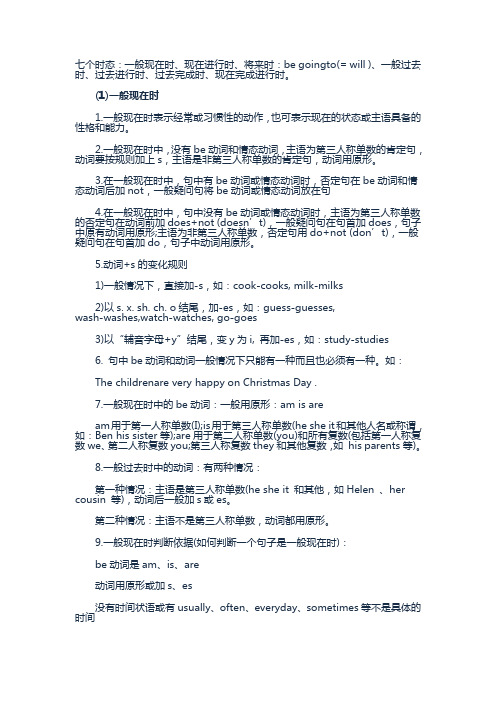
七个时态:一般现在时、现在进行时、将来时:be goingto(= will )、一般过去时、过去进行时、过去完成时、现在完成进行时。
(1)一般现在时1.一般现在时表示经常或习惯性的动作,也可表示现在的状态或主语具备的性格和能力。
2.一般现在时中,没有be动词和情态动词,主语为第三人称单数的肯定句,动词要按规则加上s,主语是非第三人称单数的肯定句,动词用原形。
3.在一般现在时中,句中有be动词或情态动词时,否定句在be动词和情态动词后加not,一般疑问句将be动词或情态动词放在句4.在一般现在时中,句中没有be动词或情态动词时,主语为第三人称单数的否定句在动词前加does+not (doesn’t),一般疑问句在句首加does,句子中原有动词用原形;主语为非第三人称单数,否定句用do+not (don’t),一般疑问句在句首加do,句子中动词用原形。
5.动词+s的变化规则1)一般情况下,直接加-s,如:cook-cooks, milk-milks2)以s. x. sh. ch. o结尾,加-es,如:guess-guesses,wash-washes,watch-watches, go-goes3)以“辅音字母+y”结尾,变y为i, 再加-es,如:study-studies6. 句中be动词和动词一般情况下只能有一种而且也必须有一种。
如:The childrenare very happy on Christmas Day .7.一般现在时中的be动词:一般用原形:am is aream用于第一人称单数(I);is用于第三人称单数(he she it和其他人名或称谓,如:Ben his sister等);are用于第二人称单数(you)和所有复数(包括第一人称复数we、第二人称复数you;第三人称复数they和其他复数,如his parents等)。
8.一般过去时中的动词:有两种情况:第一种情况:主语是第三人称单数(he she it 和其他,如Helen 、her cousin 等),动词后一般加s或es。
英语八大时态整理笔记

英语八大时态整理笔记一、时态的定义和用法:①一般现在时:表示现在经常发生的动作或存在的状态。
常与always, often, sometimes, every day等时间状语连用。
②现在进行时:表示正在进行的动作或存在的状态。
常与now, at present等时间状语连用。
③现在完成时:表示过去发生的动作对现在造成的影响或结果。
常与already, yet, still等词连用。
④现在完成进行时:表示从过去某一时刻开始一直延续到现在的动作或状态,并可能继续延续下去。
⑤过去一般时:表示过去经常发生的动作或存在的状态。
常与often, always等时间状语连用。
⑥过去进行时:表示过去某个时间正在进行的动作或存在的状态。
常与at that time, at this time yesterday等时间状语连用。
⑦过去完成时:表示过去的过去,即在过去的某个时间之前已经发生的动作或存在的状态。
常与before, until, when等词连用。
⑧过去完成进行时:表示过去某个时间之前已经开始并一直延续到那个时间的动作或状态,并可能继续延续下去。
二、时态的构成形式:①一般现在时:主语+动词原形(+副词性短语)+其他成分(+时间状语)②现在进行时:主语+be动词(am/is/are)+动词的现在分词(+其他成分)③现在完成时:主语+have/has+动词的过去分词(+其他成分)④现在完成进行时:主语+have/has+动词的现在分词(+其他成分)⑤过去一般时:主语+动词的过去式(+其他成分)(+时间状语)⑥过去进行时:主语+was/were+动词的现在分词(+其他成分)(+时间状语)⑦过去完成时:主语+had+动词的过去分词(+其他成分)(+时间状语)⑧过去完成进行时:主语+had+动词的现在分词(+其他成分)(+时间状语)三、注意事项:①时态的变化:英语时态的变化比较复杂,包括动词的变化、助动词的变化以及时间状语的变化等。
- 1、下载文档前请自行甄别文档内容的完整性,平台不提供额外的编辑、内容补充、找答案等附加服务。
- 2、"仅部分预览"的文档,不可在线预览部分如存在完整性等问题,可反馈申请退款(可完整预览的文档不适用该条件!)。
- 3、如文档侵犯您的权益,请联系客服反馈,我们会尽快为您处理(人工客服工作时间:9:00-18:30)。
现在进行时和现在完成进行时区分:区分 have done 和 have been doing,我们需要从两个方面来讨论:一、完成时态和完成进行时态本身意义的差别;二、要结合动词的不同延续特点.首先我们来看两种时态的意义差别两者根本区别是:完成进行时强调动作持续的过程(emphasis on duration), 完成时强调动作的结果或成就 (emphasis on achievement).具体来讲 ,现在完成进行时have been doing 强调的是在一段时期内某项活动的持续性,强调的是动作本身.现在完成时have done 则是强调动作产生的结果或取得的成就,而不是动作本身.二者的这种区别我们从下面的这些例句可以很好地领悟到: (2) a. My hands are very dirty. I ’ ve been painting the house. b. I have painted the house green. The house was white, but now it ’s green.思维分析:句a 中 have been painting 表示 painting 动作一直在持续 ,活动还没有结束 ,所以才有 my hands are very dirty 这样的现状 .句 a 意思是“我的手很脏,我现在一直在给房间刷漆”.句 b 中 have painted 表示 painted 动作已经结束 ,而且动作导致的结果是the house was white, but now it ’ s green 房间现在是绿色的了.现在完成时表示动作业已完成, 而完成进行时却不一定如此I ’ve made a cake. 我做了一个蛋糕.(已做好)I ’ve been making a cake. 我一直在做一个蛋糕. (不一定做好了She’ s painted a picture. 她画了一幅画 .(已画好)She’ s been painting a picture. 她在画一幅画 .(可能还没画好)强调时间长度用完成进行时比较好:I’ve been coughing all night.我咳了一整夜.(比I ’ve coughed all night.更能强调咳得久)All the time she ’s been sitting there in silence.她一直静坐在那里.All these years we ’ve been trying to get in touch with him.这些年来我们一直在设法和他联系.许多静态动词都只能用于完成时而不能用于完成进行时:I ’ve known that for a long time.这事我已经知道很久了.The strike has lasted six months. 这次罢工已经持续了 6 个月 .Nobody has seen him since last week. 从上周起就没人见到过他.raise in salary all the time.他一直盼着加薪.但当意思发生转变时也可能用于完成进行时:I ’ve been thinking of doing so for a long time.我好久以来一直想这样做.Tom has been seeing about a work permit for you.汤姆一直在设法帮你取得工作许可证.有少数动词用两种时态都可以,意思差别不大,如:They have been working very well this term.这学期他们学习很好. They have worked very well this term.It has been raining for two hours.下了两个小时的雨. It has rained for two hours.过去完成时一、过去完成时的概念与结构特点即“过去的过概念:过去完成时表示在过去某一时间或动作之前已经发生或完成了的动作,去( past-in-the-past )”。
----|--------------------------|-------------------------------|---------------------------->那时以前那时现在构成:过去完成时由“助动词 had + 过去分词”构成,其中 had 通用于各种人称。
They had already had breakfast before they arrived at the hotel. She had finished writing the composition by 10 : 00 this morning.二、过去完成时的判断依据1. 由时间状语来判定一般说来,各种时态都有特定的时间状语。
与过去完成时连用的时间状语有:(1)by +过去的时间点。
如: I had finished reading the novel by nine o'clock last night.(2 ) by the end of + 过去的时间点。
如: We had learned over two thousand English words by the end of last term.( 3 ) before + 过去的时间点。
如: They had planted six hundred trees before last Wednesday. 2. 由“过去的过去”来判定。
过去完成时表示“过去的过去”,是指过去某一动作之前已经发生或完成的动作,即动作有先后关系,动作在前的用过去完成时,在后的用一般过去时。
这种用法常出现在:( 1 )宾语从句中当宾语从句的主句为一般过去时,且从句的动作先于主句的动作时,从句要用过去完成时。
在told, said, knew, heard, thought等动词后的宾语从句。
如:She said that she had seen the film before.(2)状语从句中在时间、条件、原因、方式等状语从句中,主、从句的动作发生有先后关系,动作在前的,要用过去完成时,动作在后的要用一般过去时。
如:When I got to the station, the train had already left.After he had finished his homework, he went to bed.注意: before, after 引导的时间状语从句中,由于 before 和 after 本身已表达了动作的先后关系,若主、从句表示的动作紧密相连,则主、从句都用一般过去时。
如:Where did you study before you came here?After he closed the door, he left the classroom.(3 )表示意向的动词,如 hope, wish, expect, think, intend, mean, suppose 等,用过去完成时表示 "原本 , ,未能,"We had hoped that you would come, but you didn't. 3.根据上、下文来判定。
I met Wang Tao in the street yesterday. We hadn't seen each other since he went to Beijing.三、过去完成时的主要用法1.过去完成时表示一个动作或状态在过去某一时间或动作之前已经完成或结束,即发生在“过去的过去”。
如:When I woke up, it had stopped raining.我醒来时,雨已经停了。
(主句的动作发生在“过去的过去”)2. 过去完成时是一个相对的时态,表示的是“过去的过去”,只有和过去某一时间或某一动作相比较时才使用它。
如:He told me that he had written a new book. (had written发生在told之前)3. 过去完成时需要与一个表示过去的时间状语连用,它不能离开过去时间而独立存在。
此时多与 already , yet , still , just , before , never 等时间副词及by , before , until 的短语或从句连用。
如等引导:Before she came to China, Grace had taught English in a middle school for about five years.Peter had collected more than 300 Chinese stamps by the time he was ten.4. 过去完成时表示某一动作或状态在过去某时之前已经开始,一直延续到这一过去时间,而且动作尚未结束,仍然有继续下去的可能。
如: By the end of last year, he had worked in the factory for twenty years.了 20 年,还有继续进行下去的可能)(had worked已有5.过去完成时也用于hardly...when...(刚,就,), no sooner...than...(刚,就, ) , It was the first time + that等一些固定句型中。
He had no sooner left the room than they began to talk about him. 他刚离开房间,他们就议论起他来。
We had hardly begun when we were told to stop.我们刚开始就被叫停。
It was the first time that he had ever spoken to me in such a tune. 他用这样的语调跟我讲话,这是第一次。
四、过去完成时与现在完成时的区别现在完成时表示的动作发生在过去,但侧重对现在产生的结果或造成的影响,与现在有关,其结构为“助动词 have (has) + 过去分词”;过去完成时则是一个相对的时态,它所表示的动作不仅发生在过去,更强调“过去的过去”,只有和过去某时或某动作相比较时,才用到它。
试比较:I have learned 1000 English words so far.到目前为止我已经学会了1000个英语单词。
